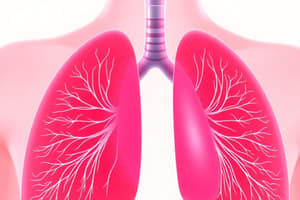Podcast
Questions and Answers
What is the total pulmonary ventilation during rest?
What is the total pulmonary ventilation during rest?
- 3L/min
- 5L/min
- 6L/min (correct)
- 7L/min
Which lung capacity prevents airway collapse and requires an unusually large pressure to reinflate the airways after a collapse?
Which lung capacity prevents airway collapse and requires an unusually large pressure to reinflate the airways after a collapse?
- Vital capacity
- Functional residual capacity
- Inspiratory capacity
- Residual volume (correct)
What is the maximum amount of air that can be inspired after quiet expiration?
What is the maximum amount of air that can be inspired after quiet expiration?
- Inspiratory reserve volume (correct)
- Functional residual capacity
- Expiratory reserve volume
- Tidal volume
Which pulmonary function test involves comparing an individual's FVC and FEV1?
Which pulmonary function test involves comparing an individual's FVC and FEV1?
What does a low initial FVC indicate in a pulmonary function test?
What does a low initial FVC indicate in a pulmonary function test?
What is the sum of Inspiratory Reserve Volume (IRV), Tidal Volume (TV), and Expiratory Reserve Volume (ERV)?
What is the sum of Inspiratory Reserve Volume (IRV), Tidal Volume (TV), and Expiratory Reserve Volume (ERV)?
Flashcards are hidden until you start studying
Study Notes
Lung Volumes
- Tidal volume: 500 ml of air that enters or exits the lungs during quiet respiration
- Total pulmonary ventilation: 6L/min, calculated by multiplying tidal volume and frequency of breathing (TV x frequency of breaths)
Reserve Volumes
- Inspiratory reserve volume: 3000 ml of additional air that can be inspired after quiet inspiration
- Expiratory reserve volume: 1100 ml of air that can be expired after quiet respiration
- Residual volume: 1200 ml of air remaining in the lungs after maximal expiratory effort
Functions of Residual Volume
- Prevents airway collapse, making it difficult to reinflate after a collapse
- Allows continuous exchange of gases
Lung Capacities
- Total lung capacity: sum of four volumes (TLC = IRV + TV + ERV + RV)
- Functional residual capacity: sum of ERV and RV, representing the capacity of air remaining in the lungs following quiet expiration
- Inspiratory capacity: maximal amount of air that can be inspired after quiet expiration, calculated by adding IRV and TV (IC = IRV + TV)
- Vital capacity: maximal achievable air moved with a single breath, calculated by adding IRV, TV, and ERV (VC = IRV + TV + ERV)
Pulmonary Function Test
- Tests an individual's forced vital capacity (FVC) and compares it to their forced expired volume in one second (FEV1)
- Low initial FVC indicates restrictive lung disease, characterized by a decrease in lung compliance
- FEV1 is normally 80% of FVC
Studying That Suits You
Use AI to generate personalized quizzes and flashcards to suit your learning preferences.




